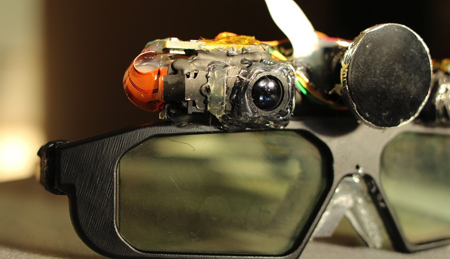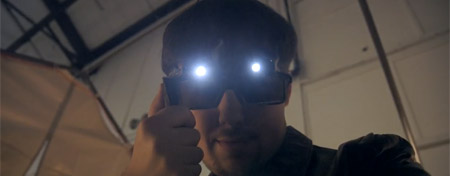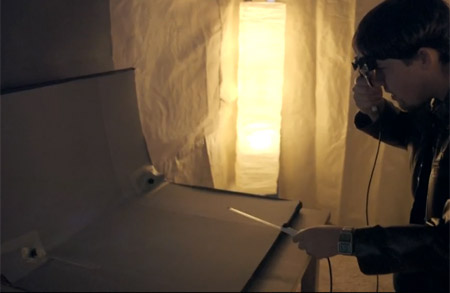Throwing the image
CastAR

CastAR Goggles. Image (C) The Verge
The Verge guys have been looking at the cool new rough prototype of a set of the new inverted augmented reality goggle concept from the engineers, that ditched Valve. Valve seems to concencreate on what they do best: building (regular) VR games for our pleasure. But for the risky passion, we can now see the new team rising: CastAR.
Their approach is – let’s say – reversed and integrates many different components to make another immersion style possible. They do not go for the typical AR style of holding a device between you and your environment – nor are they using a fixed projector to cast augmentations onto a blank object (the classic static or dynamic projection mapping). What do they do?

Head-Mounted Projector of CastAR prototype. Image (C) TheVerge
They use sci-fi looking pico projectors mounted to each user’s head (two for each!) to cast the image from the user into the room, that has a retro-reflective paint on the surfaces. Additionally, the user has shutter glasses on to get a stereo image from the two head-mounted projectors. But wait, there is more! Now they also track the user outside-in via IR diodes to get the correct perspectives.

Overall setup. IR diodes at the corner of the workspace for tracking. Image (C) TheVerge
But wait, there is more! The mentioned retro-reflective painted surfaces now even allow a multi-user scenario! How is that? Typically, an immersive environment is a one-man-show: a user (possibly with stereo goggles) stands inside a CAVE or another immersive setup and gets his/her perspective right by some means of tracking. A second user would see the same images, that were generated for the first user only. Stereo and/or perspective would not work for another person… A time multiplexing could solve this, i.e. using a shutter glasses system with matched projector frequency to generate image 1, 2 for user A, next images 3, 4 for user B, then 5 and 6 for user 1 again, etc. This way the update frequency will drop drastically and is usually too complex to achieve. Nevertheless, there sure would be use cases to allow multi-user collaborative setups (or games)…
… now the CastAR dudes came up with the head-mounted projector concept plus retroreflection: the light is only cast back towards the source of the light (the user’s head). Looking from another angle will return a dark unlit object. No interferences between multiple users to be expected in theory and a perfect world!
This is a pretty damn clever idea to combine these things together for a new gadget research! I’d love to see it live and give hands-on feedback. The guys from TheVerge seem to be impressed with the very low latency (for the tracking and image generation) and stereo combined with retro-reflection seemed to have very little cross-talk (ghosting from other user’s images within your view). The setting with the tiny projectors did cast enough light to work even in a moderately sunlit room. Can’t wait for the upcoming Kickstart project to see this getting to the next level!
Nevertheless, we sure would need to check, where this can really be used. Multi-user scenarios are a big plus and not overlaying the user’s eyes another one (sometimes video-see-through being a no-no! for security). But probably nobody wants to paint their furnitures white/grey with the not too cheap retro-reflective paint… Of course, marketing and Sales should figure that out… for now we enjoy the tech demo and TeamFortress!!!
Neat!
